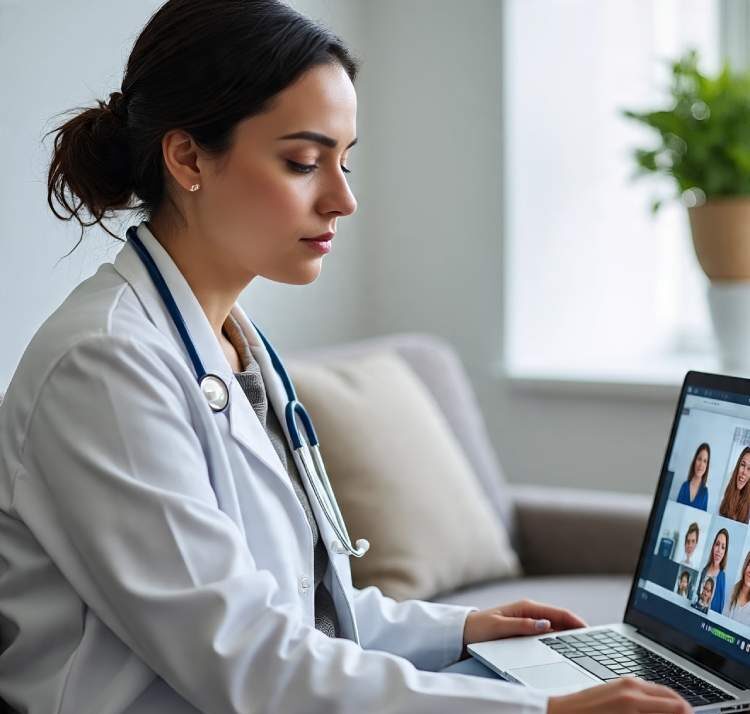Essential Guide to Remote Patient Monitoring Nursing in US (2025)

Essential Guide to Remote Patient Monitoring Nursing in US (2025)
Remote patient care is no longer just a futuristic idea—it’s the reality shaping healthcare today. In 2025, Remote Patient Monitoring Nursing in US has become an essential approach for managing chronic conditions, supporting post-hospital recovery, and ensuring timely interventions for patients right from their homes.

This guide will walk you through everything nurses need to know—from the basics of remote monitoring to the skills, tools, and best practices required to succeed in this evolving role.
The rise of wearable devices, smart health apps, and AI-driven platforms has revolutionized the way nurses track patient health. No longer limited to in-person visits, nurses can now monitor blood pressure, heart rhythms, glucose levels, oxygen saturation, and even medication adherence in real time. This not only improves patient safety but also reduces hospital readmissions and cuts healthcare costs significantly. For patients, it means greater convenience and access to care; for nurses, it means expanding their expertise and embracing a new model of professional practice.
But how exactly does this transformation affect nursing today? Remote monitoring is not just about technology—it’s about building strong nurse-patient relationships in a virtual setting, ensuring accurate documentation, and being able to respond quickly to red flags. Nurses are the bridge between digital data and human care, interpreting vital signs, educating patients, and coordinating with providers to make informed clinical decisions.
This Essential Guide to Remote Patient Monitoring Nursing in US will explore the latest tools nurses are using in 2025, the challenges and solutions in implementing remote care, the legal and ethical considerations, and the steps every nurse can take to thrive in this fast-growing field. Whether you are an experienced nurse looking to expand your role or a new graduate eager to enter a future-ready specialty, this guide will equip you with the insights needed to stay ahead.
The future of nursing is here—and it’s digital, data-driven, and patient-centered. By mastering remote patient monitoring, you’re not just keeping up with the times—you’re shaping the future of healthcare delivery in the United States.
💰 Average Nurse Salary in USA (2025) – State-by-State Guide: How Much Nurses Really Make
What Is Remote Patient Monitoring in Nursing?
Remote Patient Monitoring (RPM) is a form of healthcare delivery that uses technology to track patients’ vital signs, symptoms, and health status outside of traditional clinical settings.

In the context of Remote Patient Monitoring Nursing in US, it means nurses are actively involved in observing, interpreting, and acting on patient data transmitted through connected devices such as blood pressure cuffs, glucose monitors, smart scales, or wearable heart monitors.
The primary goal of RPM is to improve patient outcomes by providing real-time insights into health trends without requiring frequent hospital or clinic visits. For example, a nurse can monitor a heart failure patient’s daily weight to detect early fluid retention, or track a diabetic patient’s blood glucose readings to prevent dangerous spikes. With this proactive approach, nurses can quickly identify problems, educate patients on corrective steps, and coordinate with physicians for timely interventions.
In 2025, RPM has become especially vital in the United States because of three major healthcare shifts:
-
An aging population that needs continuous monitoring for chronic conditions.
-
A surge in telehealth adoption accelerated by the pandemic, which normalized virtual care.
-
Advancements in digital health technology, making devices more affordable, accurate, and user-friendly.
For nurses, RPM is more than a technical task. It requires clinical judgment, strong communication skills, and the ability to reassure patients who may feel anxious about their data. Nurses act as the frontline professionals interpreting digital information, bridging the gap between technology and compassionate care.
In short, Remote Patient Monitoring Nursing in US is about empowering patients with independence while ensuring that critical data never goes unnoticed. It transforms nursing from a reactive to a proactive role—catching problems early, reducing hospitalizations, and improving overall quality of care.
Surprising Telehealth Nursing Training Tips for Success in US 2025
Key Tools and Technologies in Remote Patient Monitoring Nursing (2025)
Remote Patient Monitoring (RPM) has advanced rapidly, and nurses in 2025 now rely on a wide range of devices and platforms to track patients’ health in real time. These tools not only provide accurate data but also empower nurses to make informed decisions that directly improve patient care.

Below are the most commonly used technologies in Remote Patient Monitoring Nursing in US:
1. Wearable Devices
Smartwatches and biosensors can monitor heart rate, oxygen saturation (SpO₂), sleep patterns, and even detect arrhythmias. Nurses review this data to identify irregularities and provide timely feedback.
2. Connected Glucose Monitors
For diabetic patients, continuous glucose monitors (CGMs) automatically send readings to healthcare providers. Nurses play a critical role in interpreting these results and guiding patients on medication adjustments and lifestyle changes.
3. Blood Pressure and Cardiac Monitoring Devices
Portable, Bluetooth-enabled blood pressure cuffs and ECG patches allow nurses to track cardiovascular health remotely. Sudden spikes or irregular rhythms can trigger alerts, enabling early intervention.
4. Smart Scales and Weight Trackers
Particularly useful for patients with congestive heart failure, smart scales detect small changes in weight that may indicate fluid retention. Nurses can act quickly to prevent hospital admissions.
5. Medication Adherence Tools
Smart pillboxes and reminder apps notify patients when it’s time to take medication. Nurses can monitor adherence reports and intervene if doses are missed.
6. Telehealth Platforms with Integrated RPM
Systems like Epic, Teladoc, and Amwell integrate video consultations with RPM data dashboards. This gives nurses a complete patient view during virtual visits, ensuring care is seamless and comprehensive.
7. AI-Driven Analytics Tools
Artificial intelligence enhances RPM by analyzing trends and predicting risks. Nurses using these tools can identify subtle patterns—like gradual oxygen decline—that may not be obvious in single data points.
Together, these technologies make Remote Patient Monitoring Nursing in US a more proactive, precise, and patient-centered practice. By mastering these tools, nurses not only enhance patient safety but also expand their role as leaders in digital healthcare.
Easy Opportunity: Top Travel Nursing Agencies in the US Hiring in 2025
Benefits of Remote Patient Monitoring for Nurses and Patients
The adoption of Remote Patient Monitoring Nursing in US goes far beyond convenience—it delivers measurable benefits for patients, nurses, and the entire healthcare system. In 2025, RPM has become one of the most effective ways to improve care quality while reducing costs.
For Patients:
-
Better Access to Care – Patients in rural or underserved areas can receive consistent monitoring without frequent travel to clinics.
-
Improved Health Outcomes – Continuous monitoring detects problems early, preventing complications and unnecessary hospitalizations.
-
Greater Independence – Patients feel empowered to manage their health with support from wearable devices and nurse-guided feedback.
-
Convenience and Comfort – Monitoring happens at home, reducing stress and disruption to daily life.
-
Enhanced Patient Engagement – Seeing their own health data in real time motivates patients to make positive lifestyle changes.
For Nurses:
-
Early Detection of Issues – Nurses can act on warning signs before conditions worsen, making care proactive instead of reactive.
-
Stronger Patient Relationships – Frequent virtual check-ins and timely feedback build trust and encourage open communication.
-
Time Efficiency – With automated data collection, nurses spend less time on routine checks and more time on patient education and care planning.
-
Expanded Career Opportunities – RPM nursing opens new roles in telehealth, digital health, and care coordination.
-
Professional Growth – Nurses who master digital tools become leaders in the future of healthcare delivery.
For the Healthcare System:
-
Reduced hospital readmissions and emergency visits.
-
Lower overall healthcare costs.
-
Improved quality metrics and patient satisfaction scores.
In short, Remote Patient Monitoring Nursing in US strengthens the connection between technology and human care. Patients gain safety and convenience, while nurses gain efficiency, empowerment, and a stronger role in shaping the future of healthcare.
Easy Guide: How long does nclex processing take for foreign nurses in US (2025 Update)
Challenges and Solutions in Remote Patient Monitoring Nursing
While Remote Patient Monitoring Nursing in US offers tremendous advantages, it is not without its challenges. Nurses in 2025 are learning how to balance technology with compassionate care while addressing barriers that affect both patients and providers.

Below are the most common challenges—and the solutions that make RPM more effective.
1. Technology Barriers
-
Challenge: Some patients struggle with setting up or using devices, leading to incomplete or inaccurate data.
-
Solution: Nurses can provide simple setup instructions, offer technical support hotlines, and recommend user-friendly devices designed for older adults or those less tech-savvy.
2. Data Overload
-
Challenge: Constant streams of health data can overwhelm nurses and providers.
-
Solution: AI-driven platforms and smart dashboards help filter critical alerts, allowing nurses to focus only on actionable information.
3. Privacy and Security Concerns
-
Challenge: Storing and transmitting sensitive health data raises HIPAA compliance and cybersecurity concerns.
-
Solution: Nurses should be trained in secure data handling, while organizations invest in encrypted platforms with strong privacy safeguards.
4. Cost of Devices and Platforms
-
Challenge: Not all patients can afford wearable devices or remote monitoring services.
-
Solution: Insurance companies and Medicare increasingly cover RPM, and many hospitals provide loaner devices to patients who qualify. Nurses can also advocate for affordable access programs.
5. Integration with Workflow
-
Challenge: Nurses may feel RPM adds extra tasks to their already busy schedules.
-
Solution: Training programs can show nurses how to streamline digital documentation and incorporate RPM into daily workflows, making it more of a support system than a burden.
6. Patient Engagement
-
Challenge: Some patients become passive, relying on devices instead of actively managing their health.
-
Solution: Nurses should emphasize patient education, showing how data empowers self-care rather than replacing personal responsibility.
By addressing these obstacles, Remote Patient Monitoring Nursing in US can continue to expand its role in modern healthcare. Nurses who stay adaptable and proactive will not only overcome these challenges but also set the standard for safe, patient-centered remote care.
California NCLEX Requirements for Foreign Nurses in 2025 – Easy Guide
Skills Every Nurse Needs for Remote Patient Monitoring
To succeed in Remote Patient Monitoring Nursing in US, nurses need more than clinical knowledge. They must combine traditional patient care skills with digital literacy and strong communication abilities to deliver effective virtual care. Here are the top skills every nurse should develop in 2025:
1. Digital Literacy
Nurses must be comfortable using wearable devices, mobile apps, and RPM platforms. Understanding how to troubleshoot common tech issues helps both patients and the care team.
2. Data Interpretation
Remote monitoring generates constant streams of health information. Nurses need to analyze trends, identify red flags, and prioritize urgent alerts without being overwhelmed by unnecessary details.
3. Communication Skills
Virtual care limits face-to-face interaction, making clear communication more important than ever. Nurses must use empathy, active listening, and patient-friendly language to build trust across digital platforms.
4. Patient Education and Coaching
RPM is only effective if patients engage with the process. Nurses play a key role in teaching patients how to use devices, interpret their own data, and stay motivated in managing their health.
5. Clinical Judgment
Even with advanced technology, nursing judgment remains critical. Nurses must assess whether abnormal data requires immediate intervention, routine follow-up, or adjustments in patient care plans.
6. Adaptability
Healthcare technology is constantly evolving. Nurses need the flexibility to learn new platforms quickly and adjust to emerging care models without resistance.
7. Ethical and Legal Awareness
Because RPM involves sensitive health information, nurses must understand HIPAA regulations, data privacy, and ethical responsibilities to protect patient trust.
8. Collaboration and Teamwork
RPM often involves multidisciplinary teams, including physicians, IT specialists, and case managers. Strong teamwork ensures seamless patient care across all touchpoints.
By building these skills, nurses can thrive in Remote Patient Monitoring Nursing in US, delivering not just digital data management, but compassionate, safe, and proactive patient care.
Easiest Route: EB-3 Visa Process for Nurses 2025 – Step-by-Step Guide
The Future of Remote Patient Monitoring Nursing in the US (2025 and Beyond)
As healthcare continues to evolve, Remote Patient Monitoring Nursing in US is set to become one of the most transformative forces in patient care. By 2025, RPM is no longer a supplemental tool—it’s a core strategy for hospitals, clinics, and community health programs across the country. But what lies ahead?
1. AI and Predictive Analytics
Artificial intelligence is being increasingly integrated into RPM platforms, helping nurses identify risks before they escalate. For example, AI can flag subtle patterns in blood pressure or oxygen levels that may indicate an upcoming cardiac event, allowing nurses to intervene early.
2. Expanded Role for Nurses
Nurses are moving from bedside caregivers to digital care coordinators, educators, and data interpreters. This shift opens new career paths in telehealth, chronic disease management, and virtual nursing leadership.
3. Wearables and Smart Home Integration
Future devices won’t just track vitals—they’ll integrate seamlessly with smart homes. Imagine a home environment where blood pressure cuffs, oxygen monitors, and smart speakers all sync, providing nurses with a complete patient snapshot in real time.
4. Broader Access Through Insurance
With Medicare, Medicaid, and private insurers increasingly reimbursing RPM services, more patients will gain access to remote monitoring, making it a standard part of chronic care management.
5. Hybrid Care Models
The future will blend in-person care with RPM and telehealth. Nurses will need to pivot between digital and physical care seamlessly, ensuring patients receive consistent, high-quality experiences.
6. Focus on Preventive Care
Instead of waiting for patients to become critically ill, RPM will drive a preventive care model—catching conditions earlier, reducing hospitalizations, and lowering long-term healthcare costs.
In short, the future of Remote Patient Monitoring Nursing in US is proactive, data-driven, and deeply patient-centered. Nurses who embrace technology, adapt to new workflows, and remain committed to compassionate care will be at the forefront of this healthcare revolution.
Conclusion: Embracing the Future of Nursing with Remote Patient Monitoring
The rise of Remote Patient Monitoring Nursing in US proves that healthcare in 2025 is more connected, proactive, and patient-centered than ever before. By combining wearable devices, digital platforms, and real-time data analysis, nurses are helping patients stay healthier at home while reducing hospital readmissions and lowering healthcare costs.
For patients, RPM means safety, independence, and peace of mind. For nurses, it represents an expanded role that blends clinical expertise with digital skills, offering new career opportunities and greater influence in the healthcare system. While challenges like technology barriers, data overload, and privacy concerns remain, the solutions are clear—and nurses are at the heart of implementing them successfully.
The message is simple: Remote monitoring is not replacing traditional nursing—it’s enhancing it. Nurses remain the essential bridge between raw health data and compassionate human care. By developing digital literacy, sharpening communication skills, and embracing innovation, today’s nurses can thrive in this new model of healthcare delivery.
The future of nursing in the US is hybrid, blending bedside care with digital oversight. Those who master Remote Patient Monitoring Nursing in US will not only keep pace with change but will lead the transformation toward safer, smarter, and more patient-focused healthcare.
Resources: Remote Patient Monitoring Nursing in US (2025)
If you’d like to explore more about Remote Patient Monitoring Nursing in US, the following trusted resources provide guidelines, research, and practical tools:
-
American Nurses Association (ANA) – http://Nursing Informatics and Digital HealthCenters for Medicare & Medicaid Services (CMS) – http://Remote Patient Monitoring Coverage & Reimbursement
-
American Telemedicine Association (ATA) – http://Telehealth and RPM Resources
-
National Council of State Boards of Nursing (NCSBN) – U.S. Food & Drug Administration (FDA) – Guidance on Medical Devices for Remote Monitoringhttp://Nursing Practice & Telehealth Regulations
-
HealthIT.gov – Interoperability and Patient Data Standards



